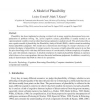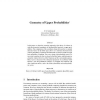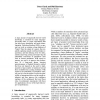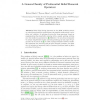105
click to vote
AMAI
2010
Springer
14 years 10 months ago
2010
Springer
The study of the interplay between belief and probability can be posed in a geometric framework, in which belief and plausibility functions are represented as points of simplices i...
110
click to vote
IDA
2010
Springer
14 years 11 months ago
2010
Springer
In this paper we introduce three alternative combinatorial formulations of the theory of evidence (ToE), by proving that both plausibility and commonality functions share the stru...
COGSCI
2006
15 years 29 days ago
2006
Plausibility has been implicated as playing a critical role in many cognitive phenomena from comprehension to problem solving. Yet, across cognitive science, plausibility is usual...
106
click to vote
ECAI
2008
Springer
15 years 2 months ago
2008
Springer
In this paper, we present a general revision model on epistemic states based on plausibility measures proposed by Friedman and Halpern. We propose our revision strategy and give so...
126
click to vote
ECSQARU
2001
Springer
15 years 5 months ago
2001
Springer
The aim of this paper is to test if conjunctive and disjunctive judgments are differently accounted for possibility and probability theories depending on whether (1) judgments are ...
101
click to vote
ISIPTA
2003
IEEE
15 years 6 months ago
2003
IEEE
In this paper we adopt the geometric approach to the theory of evidence to study the geometric counterparts of the plausibility functions, or upper probabilities. The computation ...
109
Voted
ECAI
2004
Springer
15 years 6 months ago
2004
Springer
Friedman and Halpern have introduced the inference by plausibility structures, which provides semantics for various default logics. This is a generalization of known inferences, su...
118
click to vote
KCAP
2009
ACM
15 years 7 months ago
2009
ACM
A large amount of empirically derived world knowledge is essential for many languageprocessing tasks, to create expectations that can help assess plausibility and guide disambigua...
116
click to vote
LORI
2009
Springer
15 years 7 months ago
2009
Springer
Most belief change operators in the AGM tradition assume an underlying plausibility ordering over the possible worlds which is transitive and complete. A unifying structure for the...




